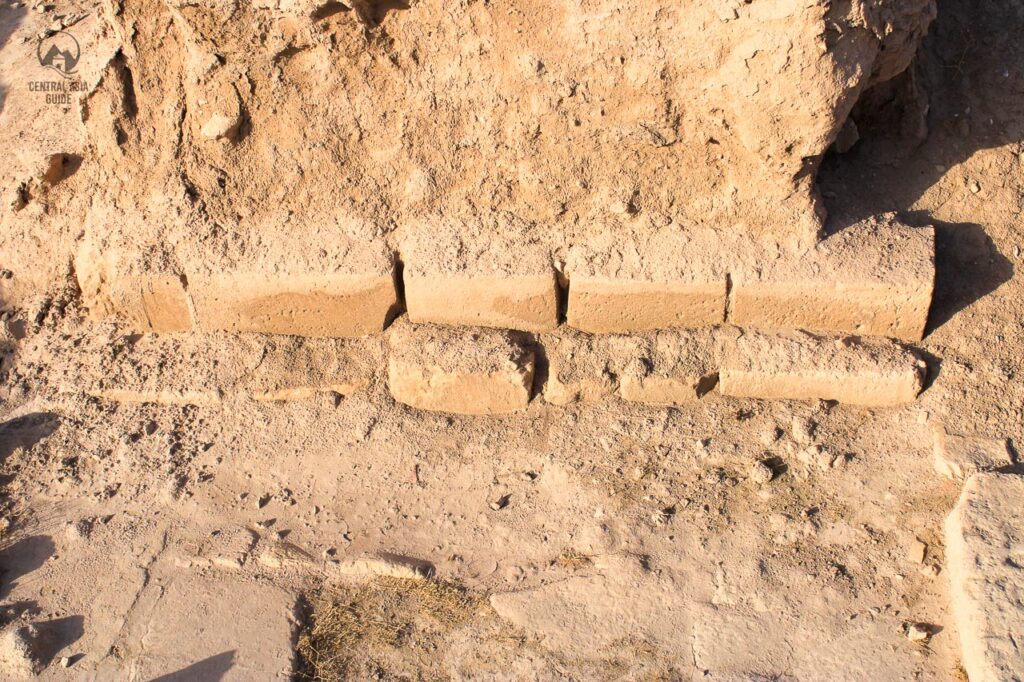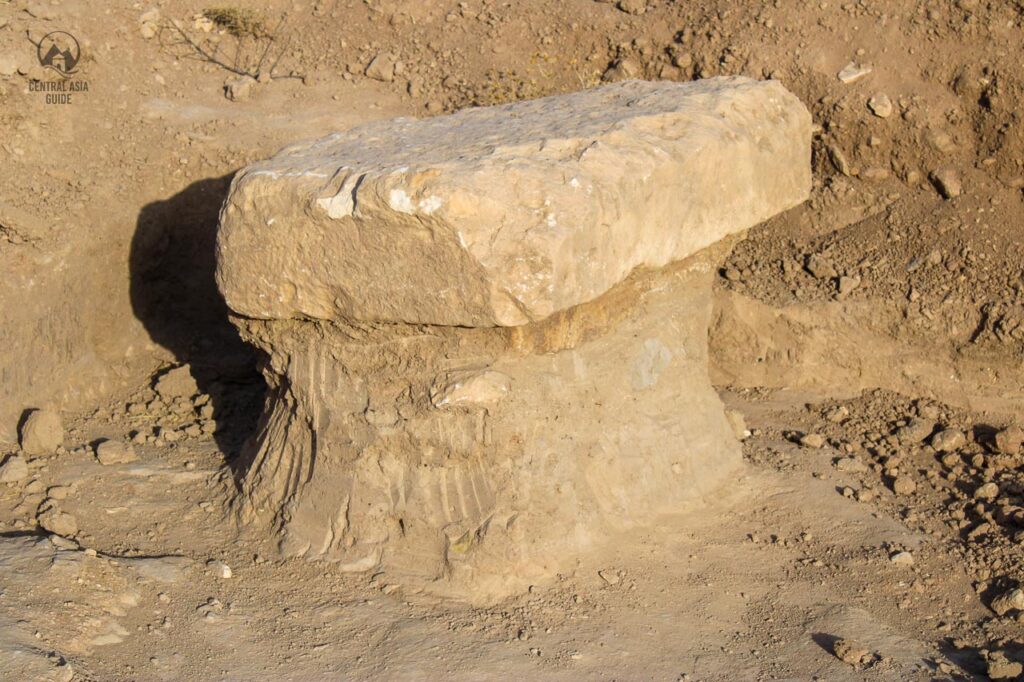Takht-i Sangin
Takht i Sangin
The Takht-i Sangin site is an archaeological site located in southern Tajikistan, near the confluence of the Vakhsh and Panj rivers, which forms the source of the Amu Darya. Takhti-Sangin translated from the Tajik language as “stone throne” is also one of the best monuments of Zoroastrianism. This site is also often referred to as Temple of the Oxus and it is one of the earliest and most significant archaeological sites in Tajikistan. In reality, the temple of Oxus is a part of Takht i Sangin and is located further south along where the name of the combined river changes to Amu Darya.


Takht i Sangin Ancient town
The site dates back to the early first millennium BCE, and it was an important center of the ancient Bactrian civilization. A large temple that was dedicated to the Oxus (Vakhsh/Amu Darya river), and it continued to be used during the following Kushan period until the third century AD. Some scholars believe that the Oxus Treasure may have originated from this site. The location of Takht-i Sangin is on a raised flat area, and it is about three km long from north to south and varying from 100 to 450 meters in width, set between the west bank of the Amu Darya river and the base of the Teshik Tosh mountain to the west. The Bactrians were a people who inhabited the region that is now northern Afghanistan, southern Uzbekistan, and western Tajikistan. People in that area were known for their skilled metalworking and their production of distinctive Bactrian (Indo-Greek) art.
The city was bounded by walls at the north and south ends, and further east-west walls divided the site into several sections. The river and the mountain provided natural defenses on the eastern and western sides of the settlement. The site was likely significant politically and religiously, which enabled it to draw resources from further afield, as the limited arable land surrounding it could not have supported it.
According to some experts, the settlement and its temple functioned as the central religious site for the worship of the Oxus for the whole of Bactria. The city was sacked in the 130s BC, probably by the Kushans, and most of the site was abandoned under their rule. The site has yielded a large number of artifacts, including bronze statues, gold jewelry, pottery, and coins. Many of these artifacts are now housed in the National Museum of Antiquities of Tajikistan in Dushanbe.


Takhti i Sangin Complex
The main feature of the Takht-i Sangin site is a complex of buildings and structures that are arranged around a central courtyard. These structures include a temple, a palace, and several smaller buildings. The temple is the most impressive structure at the site, and it was dedicated to a Bactrian god or goddess. Inside it was a monumental temple – the Temple of Oxus – with a columned hall encircled by two rows of corridors and finished with a Classical portico.
The walls of the inner sanctum were an impressive 5 m high, and in places, they were 3 m thick. The pillars would have been topped with Ionian finials, and there were numerous statues atop pedestals. Central to the temple was a magnificent carved altar at which worshippers made offerings of coins, precious metals, artworks and ritual weapons.


Takht i Sangin Archeological discoveries
Almost 5 000 artifacts have been excavated, and they clearly show Hellenistic influence. Most likely those were the gifts of church-goers to the temple: the image of Alexander the Great as Hercules, the sheath with the image of a lion holding a fallow deer, chests facings made of ivory and decorated with carved drawings, the biggest collection of arrow tips in Central Asia (more than 5 thousand), arms of Greek-Macedonian warriors. The fragments of gilt bronze helmets which looked like if made of pure gold were also found there. Discoveries of gold and ivory goods, fine glassware and alabaster also affirm the importance of Takht-i Sangin as a Silk Road trading post. The finest pieces now in the National Museum were excavated here by Soviet archaeologists in the 1970s and ’80s, and, likely, the remarkable Oxus Treasure was also discovered in the vicinity.
Within 1976 and 1991 Russian archaeologists excavated a temple on a citadel set within an enclosure of about 75 hectares. It used to be devoted to the Divinity of the river whose cult had existed there since the old days. The central columned hall of the temple was surrounded by storerooms containing more than 5 000 objects, dating from between the sixth century BC and the third century AD. The temple was built right at the end of the Achaemenid period, but some of the objects derive from an earlier date. The magnificent Oxus Treasure is thought to have been found nearby. Local legend has it that Alexander the Great also worshipped at this temple.
After all this time the archeologists and the scientists agree that there is a direct connection between Amu Darya Treasure “the Treasure of Oxus” in the British Museum and “the Temple of Oxus” in Takhti Sangin since the place of treasures discovery and the location of the temple are the same, and all treasure items are of ceremonial value. It might have happened that the treasures were moved from the temple in troubled times and hidden nearby in the riverbank. The ruins of Takhti Sangin today can be seen in the scenic valley of the rivers Panj and Vakhsh, and “the Temple of Oxus” treasures – in metropolitan museums, mainly in the British Museum in London and the Eremitage in St. Petersburg.
Travel to Takht-i Sangin
If you wish to visit, we recommend you to first visit the Museum of National Antiquities in Dushanbe. In the foyer is the altar from this site, and other artifacts excavated. The site itself is impressive, even although the artifacts have been removed and it is rarely visited. There are the excavation pits, with some dressed stone walls exposed, plinths of columns and a pit with the bones of animals sacrificed on the altar. The ancient writing on one of the stones turns out to be graffiti scratched by Russian soldiers. There is a range of hills behind, and across the reed beds of the Amu Darya lies an abandoned Afghan fort. The river cannot be reached though because of a frontier fence. Just by the site, there is a watchtower, and a ruined gun emplacement, a reminder of the political sensitivities of this volatile region.
The best way to get to the site by car or taxi. Takht-i Sangin is 37 km from Shahrituz town. From the town re-cross the Kafirnihan River to the north, and take a right turn after 200 m. It is 4 km to a crossroads, take the road to Chirik (6 km), bear right and at 7 km a T junction is reached. Turn left and left again after 2 km. The tarmac ends and there is a road leading over a pass in the hills, with fine views over the Amu Darya. On reaching the bank Takht-i Sangin is 2 km to the left, but visitors should turn right first to register at the military post at Takht-i Kulwad (2 km). From the military post, drive along the track to Takht-i Sangin.
Other sights and Destinations near Takht-i-Sangin
Page update 25.9.2024